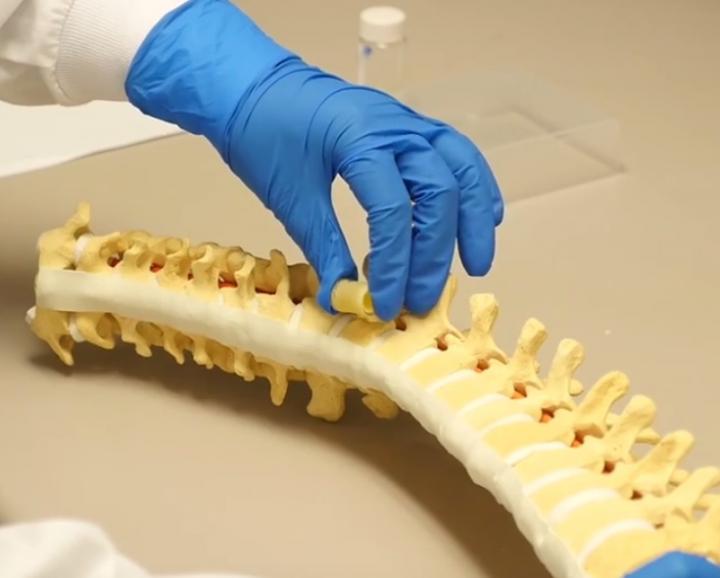

A polymer bone graft (held above in the top gloved hand) can expand in the body to just the right size to replace excised spinal tissue.
Photo credit: Lichin Lu Video credit: American Chemical Society
The researchers present their work today at the 251st National Meeting & Exposition of the American Chemical Society (ACS). ACS, the world's largest scientific society, is holding the meeting here through Thursday. It features more than 12,500 presentations on a wide range of science topics. A brand-new video on the research is available at http://bit.
“The overall goal of this research is to find ways to treat people with metastatic spinal tumors,” says Lichun Lu, Ph.D. “The spine is the most common site of skeletal metastases in cancer patients, but unlike current treatments, our approach is less invasive and is inexpensive.”
Often, removing extensive spinal tumors requires taking out the entire bone segment and adjacent intervertebral discs from the affected area. In this case, something must fill the large void to maintain the integrity of the spine and protect the spinal cord.
There are typically two surgical choices in cases of extensive spinal metastases. In the more aggressive and invasive option, the surgeon opens the chest cavity from the front of the patient, which provides enough room to insert metal cages or bone grafts to replace the missing fragment. The other approach is less invasive, requiring just a small cut in the back or posterior, but only offers enough space for the surgeon to insert short expandable titanium rods, which are costly.
To develop a less expensive graft compatible with the posterior spinal surgery option, Lu, who is at the Mayo Clinic, and her postdoctoral fellow, Xifeng Liu, Ph.D., sought a material that could be dehydrated down to a size compatible with posterior spinal surgery, and then, once implanted, absorb fluids from the body, expanding to replace the missing vertebrae.
The researchers started by crosslinking oligo[poly(ethylene glycol) fumarate] to create a hollow hydrophilic cage — the scaffold of the graft — which could then be filled with stabilizing materials, as well as therapeutics. “When we designed this expandable tube, we wanted to be able to control the size of the graft so it would fit into the exact space left behind after removing the tumor,” Lu says. The researchers also needed to control the kinetics of the expansion, because if the cage expands too quickly, a surgeon may not have enough time to position it correctly, while a slow expansion could mean a longer-than-necessary surgery.
Modifying the degree and timing of the polymer graft's expansion was a matter of chemistry, Liu says. “By modulating the molecular weight and charge of the polymer, we are able to tune the material's properties,” he says. The researchers studied the effects of these chemical changes by observing the polymer grafts' expansion rates under conditions that mimic the spinal column environment in the lab. This information is key for determining the optimal size of a spinal implant for use in restorative surgery. The team identified a combination of materials that are biocompatible in animals and that they believe will work in humans.
Lu says her lab's next step is to study the grafts in cadavers and simulate an in-patient procedure. Their goal is to initiate clinical trials within the next few years.
###
A press conference on this topic will be held Tuesday, March 15, at 10 a.m. Pacific time in the San Diego Convention Center. Reporters may check-in at Room 16B (Mezzanine) in person, or watch live on YouTube http://bit.
Lu acknowledges funding from the National Institutes of Health.
The American Chemical Society is a nonprofit organization chartered by the U.S. Congress. With more than 158,000 members, ACS is the world's largest scientific society and a global leader in providing access to chemistry-related research through its multiple databases, peer-reviewed journals and scientific conferences. Its main offices are in Washington, D.C., and Columbus, Ohio.
To automatically receive news releases from the American Chemical Society, contact newsroom@acs.org.
Note to journalists: Please report that this research is being presented at a meeting of the American Chemical Society.
Title
Oligo Poly (Ethylene Glycol) Fumarate Expandable Cages for Vertebral Body Replacement
Abstract
Expandable, biocompatible and biodegradable polymer grafts based on hydrophilic polymer systems were developed for vertebral body replacement in bone tissue engineering. The oligo poly(ethylene glycol) fumarate (OPF) is crosslinked into a hollow cage that, when placed in vivo, will expand in size to a predetermined diameter and length. This high degree of expansion will enable a less invasive posterior approach to vertebral body replacements. Once expanded in vivo, the implant will be filled with crosslinkable poly(propylene fumarate) (PPF) for structural support, bone regeneration and sustained release of chemotherapeutic or antibiotic agents. The kinetics of OPF expansion was explored by altering the molecular weight, charge and scaffold mold diameter. The effects of these changes were quantified by observing the expansion rates of scaffold length, diameter and mass under physiologic conditions. This information will be used to determine the optimal size of implant to be used to achieve complete restoration of the defect in a surgical setting.















